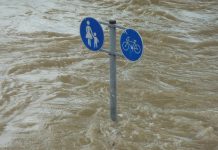A few media outlets, including CNN and BBC, have run recent articles talking about flooding in Dubai, claiming that climate change made the storms worse. This is false. There is no evidence that climate change made the rain more extreme, instead, evidence actually indicates that El Niño and even cloud seeding may have contributed.
Both the BBC’s article, “Deadly Dubai floods made worse by climate change,” and the one posted by CNN, “Scientists find the fingerprints of climate change on Dubai’s deadly floods,” reference a study done by the World Weather Attribution (WWA) group, which claimed that climate change made the rain events 10 to 40 percent more intense than if global warming was not occurring.
CNN’s writer says global warming is the likely driver of heavy rainfall in Dubai “because the atmosphere in a 1.2-degree warmer world can now hold 8.4% more moisture, which is making extreme rain events more intense.”
These claims are nonsense, and worse, non-scientific, for the simple reason that not only does data not show that heavy rainfall is becoming more intense or common, but the Intergovernmental Panel on Climate Change (IPCC) doesn’t even claim that any sign whatsoever will even begin to emerge, according to their own projections, until well into the future.
As discussed by meteorologist Anthony Watts in a previous Climate Realism post on the extreme rain in Dubai, the latest claims from the IPCC’s 6th Assessment Report show that “heavy precipitation and pluvial flooding” has not yet emerged in the current “historical period.” They have found no climate signal related to heavy rain. (See figure below)

Even if there was a climate signal in the broader data, the modelling done by WWA does not reflect real-world conditions and actually proves nothing at all. Again, several previous posts at Climate Realism (here, here, and here, as samples) have discussed in detail the issues with weather attribution “science.”
The best description of how these attribution studies work was given by statistician Dr. William Briggs in a paper compiled by the Global Warming Policy Foundation. Dr. Briggs wrote:
All attribution studies work around the same basic theme. . . . A model of the climate as it does not exist, but which is claimed to represent what the climate would look like had mankind not ‘interfered’ with it, is run many times. The outputs from these runs is examined for some ‘bad’ or ‘extreme’ event, such as higher temperatures or increased numbers of hurricanes making landfall, or rainfall exceeding some amount. The frequency with which these bad events occur in the model is noted. Next, a model of the climate as it is said to now exist is run many times. This model represents global warming. The frequencies from the same bad events in the model are again noted. The frequencies between the models are then compared. If the model of the current climate has a greater frequency of the bad event than the imaginary (called ‘counterfactual’) climate, the event is said to be caused by global warming, in whole or in part.
Fundamentally, attribution science cannot be proof of human influences on the weather via climate change, because it begins with the assumption that any given weather event is being influenced by climate change. In other words, the model is designed with the outcome in mind, making it impossible for them to “discover” anything to the contrary. In WWA’s rapidly produced attribution studies the question is never whether climate change contributed to a particular extreme weather event, but rather only, how much additional ferocity did it cause.
The WWA models cannot prove that the heavy rain in Dubai, and resultant flooding, was caused by climate change at all, much less attribute a particular percentage of the rain to climate change.
Both the BBC and CNN grudgingly acknowledge but play down the role El Niño had in the storms and flooding, despite the fact that it is a much more likely to be a contributing factor for the heavy rainfall than long-term climate change. El Niño has a significant influence on weather patterns around the world, including the United Arab Emirates. A 2016 study found that El Niño has been associated with extreme rainfall in UAE during multiple years, going back to 1982.
Although recent reports have seen the government backpedaling on this claim, when the flood stories first broke, a UAE National Center of Meteorology scientist admitted to Bloomberg that cloud seeding experiments were being run in the days leading up to the storms. This may also have played a role.
It is remarkable that journalists continue to fall for the attribution modelling con, assuming they are seeking the truth when it comes to the impact of the modest warming of the past century. However, if these journalists are instead intending to act as just a mouthpiece for weather attribution propaganda in furtherance of the climate crisis narrative, then they are guilty of knowingly deceiving their audiences who may lack the background knowledge allowing them to recognize that attribution modelling, as currently practiced, is unscientific. In either case, the BBC and CNN are misleading their readers.


















